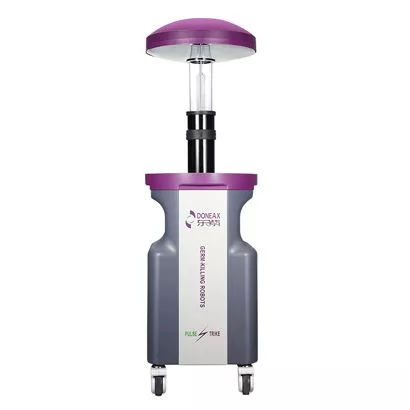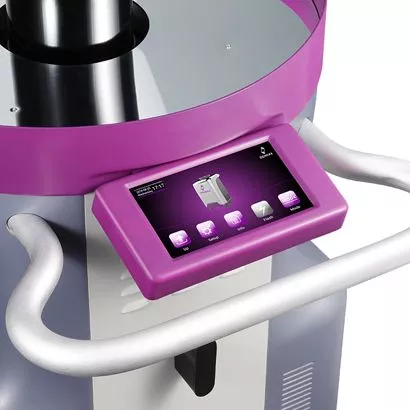What does research say about Pulsed UVC Robot?
2022-03-30 by hqt
What is the best way to disinfect rooms from viruses and bacteria? What are the types of Pulsed UVC Robot? In any ultraviolet emitters, uv of a certain spectrum generate effective rays to kill germs. It directs in different directions or in a certain zone to disinfect the air and surfaces of objects that are in the zone of UV rays.
Depending on the spectrum and wavelength of light radiation, the degree of destructive effect of ultraviolet radiation on harmful microorganisms also differs.
Radiation in the UV-C range with a peak of 200nm -315nm has the most detrimental effect on the molecular structure of microorganisms - microbes, bacteria and viruses. They have a destructive effect on their DNA.
What are the types of Pulsed UVC Robot?
UVC Robot, in which the bulb is usually made of quartz glass, which transmits a certain spectrum of UV radiation that generates ozone. In addition, it disinfects the air environment and contact surfaces especially effectively, destroys all viruses, microbes and bacteria. It purifies the air from them by almost 100%.
Bactericidal ultraviolet xenon Robots
They have a bactericidal effect on the indoor air. The UV radiation of Pulsed UVC Robot creates an air barrier for the entry of viruses and bacteria into the room. Bacterial ultraviolet xenon robots can kill all harmful organisms such as Bacteria, Fungi and viruses. It is the best and safest disinfection technique like effective, safe and fast and has been proven to be very imperative in the field of medical environment.
The air in the room is gradually cleared of pathogens
During the operation of these devices, protection of people in the room from ultraviolet radiation ensures. Since UV-treatment of air occurs in the closed volume of the decontaminator body. When the Pulsed UVC Robot is on for a certain time or constantly. The air in the room gradually clears of pathogens.
After getting acquainted with the main properties of household germicidal lamps. We will talk more about the most effective quartz UV xenon robots in the fight against viruses and microbes.
We will tell you how to choose the right UV robot for your purposes. Moreover, what functional features you should pay attention to.
Does UV radiation kill bacteria and viruses from the air and on surfaces?
Pulsed UVC Robot can carry out disinfection in the premises of hospitals and medical facilities during epidemics of respiratory viral diseases.
Exposure to ultraviolet radiation of the "C" spectrum, produced by a quartz lamp, for a certain period of time. It guarantees to eliminate microbes and viruses in the air and on the surface of objects that fall into the radiation zone.
The quality of the air we breathe and the cleanliness of the surfaces we touch have a huge impact on our health and well-being. In offices, shops, schools, museums, on public transport - in all places where there are a lot of people, we are at risk of contact with viruses and bacteria.
Moreover, we can also become their distributors. In addition, Ultraviolet radiation of the UV-C spectrum is a well-known disinfectant that has been widely used by
How long does it take for the UV xenon robots to destroy the virus?
A UV xenon robot takes less than 5 minutes to destroy viruses. Air disinfection using ultraviolet radiation is a preventive measure carried out to destroy various bacteria and viruses. Similarly, these are in the air and on open surfaces of equipment. The effectiveness of disinfection depends on the power of the bactericidal device, on the time of its operation and on the distance between the device and the disinfecting surface.
How often should the xenon robots be turned on?
Usually in the product passport it is written how often processing can carry out. In addition, most often recommended:
- Treat the air environment daily during the height of the epidemic;
- Include once or twice a week in order to prevent and prevent viral diseases.
What does research say about Pulsed UVC Robot?
The use of ultraviolet (UV) disinfection technology to reduce the risk of nosocomial infections eliminates up to 97.7% of pathogens in operating rooms. Similarly, this is reported by the results of a study published in the American Journal of Infection Control.
A study by non-profit health network Northwell Health looked at an ultraviolet light technology platform. The Pulsed UVC Robot can be used for a wide range of disinfection activities in operating rooms, patient rooms and medical facilities.
Unlike other disinfectants that can sometimes leave bacteria on a variety of surfaces, uvc robot achieves meaningful results in seconds with UV light. Research has shown that it virtually eliminates human and product errors in the spread of pathogens that can cause infection.
According to the scientists, the goal of the study was to determine whether ultraviolet technology reduces pathogens in the environment and makes healthcare facilities safer, as well as improves patient care.
“UV technology will certainly not replace manual cleaning and disinfection with chemicals. Similarly, it has a role to play in healthcare facilities. It can optimize environmental cleanliness by significantly reducing the number of pathogens that cause infection,” said study lead author
Is Pulsed UVC Robot harmful to health?
Pulsed xenon robots are not harmful for anyone because after detecting the door opening movement or the human body, it closed the machine immediately for safety ensure.
Can a UV lamp be used in the fight against coronavirus?
Pulsed UVC Robot disinfection is popular in everyday life. It provides effective assistance for high-quality disinfection of the air.
In addition, it is useful in working surfaces of premises in the treatment of infectious diseases and during epidemics of respiratory viral diseases.
All bacteria and viruses tested to date respond to UV-C radiation 2. For years, Doneax has been at the forefront of exploring the possibilities of UV technology. The company now has a proven track record of developing innovative products that use UV-C such as uvc robots.



